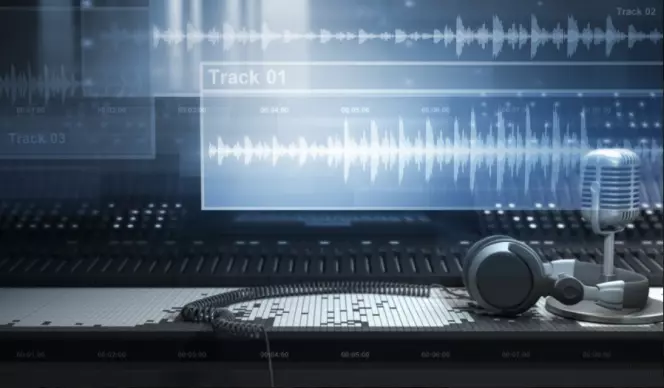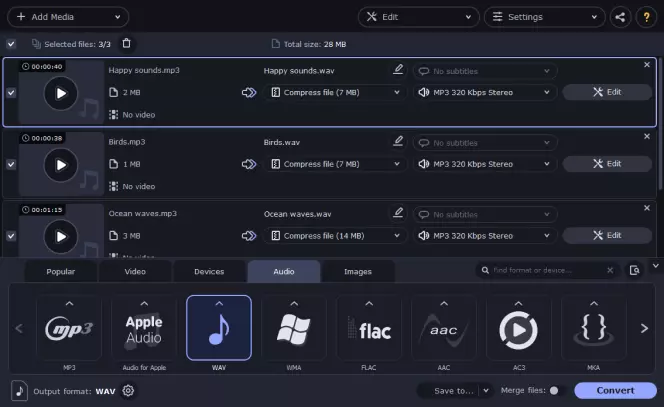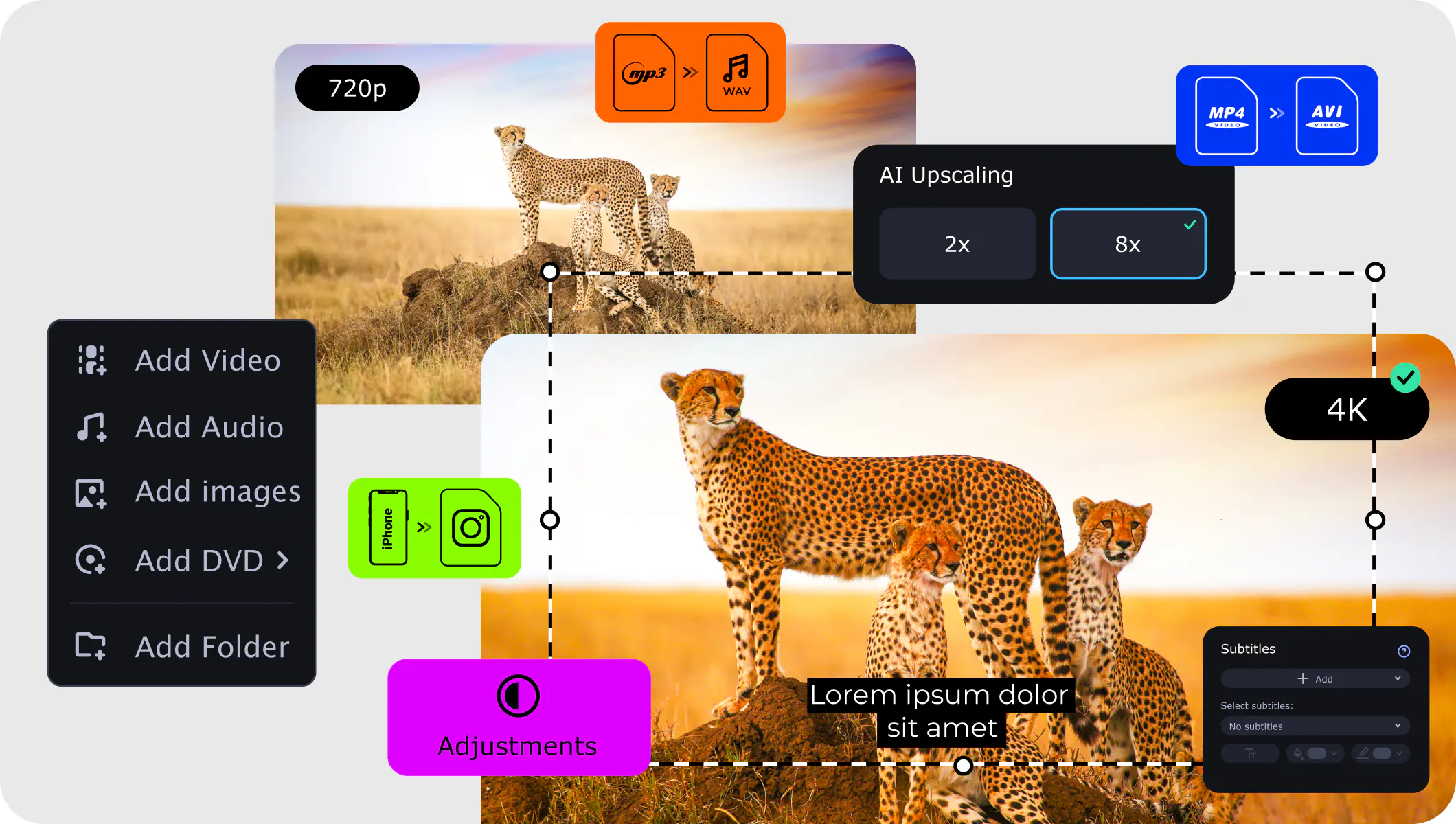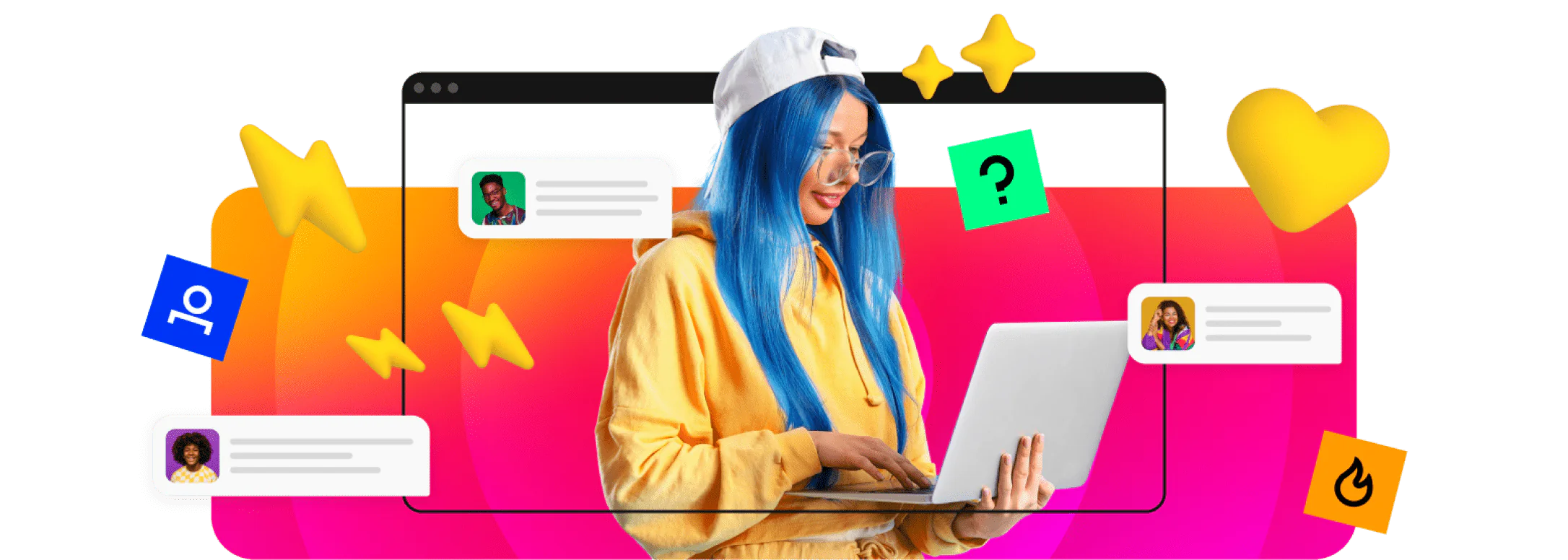If you want to change the format of your audio, use Movavi Video Converter!
- Lightning-fast conversion
- Batch processing of files – any number, any size
- No quality loss
When you're using a video converter or media player, you'll find that there are many different file formats out there, especially in the world of audio and video. FLAC and WAV are two commonly used audio formats, but which is best between FLAC vs. WAV? How to convert FLAC to WAV? Read on to find out.
Here’s what Movavi’s team does to provide you with verified information:
When selecting products to include in our reviews, we research both demand and popularity.
All the products covered in this article have been tested by our team.
When testing, we compare key characteristics, including supported input and output formats, quality loss when converting, and other significant features.
We study user reviews from popular review platforms and make use of this information when writing our product reviews.
We collect feedback from our users and analyze their opinions of Movavi software as well as products from other companies.


In order to understand the differences between WAV vs. FLAC and figure out the best option for you in the WAV versus FLAC debate, you need to know the details of each file format. So let's begin with a breakdown of what FLAC is to help you find out if FLAC or WAV is right for you.
FLAC stands for Free Lossless Audio Codec. In simple terms, the "lossless" part of the name means that you can compress other audio files into FLAC format to save space without losing any of the original sound quality.
This is one of the big advantages of FLAC, which was developed by the Xiph.Org Foundation and released in 2001. It was designed to be able to reduce audio files to around 60% of their original size, creating copies that are way smaller and easier to store or send.
As stated, those smaller and more versatile FLAC files still retain identical levels of quality. Other advantages of FLAC in the .wav vs .flac debate include the fact that it's a free and open-source format, so you can tinker around with it however you like.
In terms of compatibility, FLAC is also compatible with the vast majority of modern media players, so you shouldn't encounter any problems with running FLAC files. However, there are some compatibility issues with certain devices, and bit-depth and sample rates with FLAC are limited, so this format isn't perfect. You can convert WAV to FLAC if you need to.
Pros:
Excellent sound quality
Lossless compression for easy sharing and storage
Works on most devices
Free and open source
Cons:
Some compatibility issues may occur
Bit-depth and sample rate limitations
So, should you pick WAV or FLAC for your next audio project or download? And is WAV better than FLAC? Well, in order to understand if FLAC or WAV is better, you need to also have a thorough understanding of what WAV is and how it compares.
WAV is technically known as Waveform Audio File Format and can appear with the extension .wav or .wave, so may be referred to as either WAV or WAVE, and is pronounced like the word "Wave" in either case.
This audio format was developed by IBM and Microsoft and was originally designed for storing audio bitstreams on Windows PCs. It's been the primary audio format for storing uncompressed audio on Windows devices since its release back in 1991 and is also the standard format used on CDs.
So, what's the difference between WAV and FLAC? Well, aside from the fact that WAV is a lot older, it's another big difference between FLAC and WAV is that WAV is an uncompressed format. This means that WAV files tend to be much bigger than FLAC files.
Since it is uncompressed, WAV also performs very well in terms of pure quality and bitrate, with no limitations on things like bit-depth. So, from a technical standpoint, WAV can be seen as a slight winner in the FLAC vs. WAV quality and FLAC vs. WAV bitrate debates.
WAV, however, is not open-source. It's a proprietary format, so it is less open to modification and development. Also, as explained earlier, the files for this format can be quite large and difficult to work with at times. So, in terms of FLAC vs. WAV size, FLAC is the winner.
However, compatibility isn't an issue with WAV, like it can be with FLAC. You can play WAV files on almost any device and they're compatible with pretty much all media players and types of software, too.
Pros:
Impeccable quality levels
No restrictions on bit-depth or quality
Almost universal compatibility
Easy to work with
Cons:
Big file sizes
Not open source
Now that we know what these formats are, let’s take a look at key differences between them.
Lossy audio files lose some quality when they are compressed or converted from one form to another. Lossless, on the other hand, refers to those audio formats that report a negligible loss in quality when compressed or transferred to other formats. Since both FLAC and WAV are lossless, it becomes even more challenging to answer the question: is FLAC or WAV better?
Choosing FLAC or WAV also means you are selecting between compressed and uncompressed formats. One significant difference between FLAC and WAV is that while the former is compressed, the latter is an exact copy of the original audio file. Converting an audio file to FLAC means you are compressing it to occupy less space compared to WAV, but without any noticeable loss in quality. So, if storage space is your main concern, choose FLAC over WAV because it achieves up to 60% compression of the source file.
You need to understand the concepts of sample rate and bit depth to know how audio formats work. The sample rate and bit depth tell you how accurate a piece of digitally recorded sound can be. Without going into technicalities, it is important at the onset to state that the higher the sample rate and bit depth, the higher the quality of the piece of audio in question.
Sample rates are expressed in Hertz or kilohertz while bit depth exists in bits. The sample rate refers to how many times an audio rendering software samples the audio file within a second. If the sample rate is high, say 194kHz, it means the software samples the music 194,000 times in a second and can read lots of information from this piece.
The rendering software may draw on 16 or 24 bits of information to accurately describe an audio file. Computer geeks describe this phenomenon as the bit depth. A high bit depth, such as 32 bits, translates to higher quality audio than a lower bit depth of 8 bits.
So, how does the FLAC vs. WAV contest shape up in the light of this information? By being uncompressed, WAV loses nothing in quality but occupies more space on your device, while FLAC is compressed and may lose certain details of the file during compression. However, you won't notice any bump in quality since FLAC is lossless.
FLAC appears to beat WAV hands down on this front. The former is available for free and can be modified because it is open-source, unlike the latter, patented by Microsoft. So, if you are looking for an audio format you may wish to tinker around with, go for FLAC.
However, that is not to say WAV is inferior to FLAC. If you are not satisfied with WAV, you can still convert it to FLAC with a good video converter such as Movavi Video Editor. Though it is a video editor, it has options for converting audio files as well, hence the most convenient choice for those who wish to switch between audio formats.
Whether to choose FLAC or WAV may be no easy task. The two audio file formats are almost similar. The only difference is that one is compressed while the other isn't. It may boil down to personal preferences in using and storing media.
If you compare WAV and FLAC in terms of storage space, you will find that FLAC occupies less space due to compression. WAV will take up more space on your device, take longer to transfer between devices, and download it, which may be quite inconvenient to some users. So, if you want to choose WAV or FLAC, storage may be a significant factor coming into play.

So, is WAV or FLAC better? Well, both of these formats have their pros and cons, but you don't have to choose between them. You can make use of a converter app or tool, like Movavi Video Converter, to easily convert audio files from one format to the other.
Even though Movavi Video Converter is primarily designed for video conversion, it works just as well with converting audio files, too. Here's how to do it:
Install Movavi Video Converter. Download the installation files from the official site for your device (Windows or Mac) and then follow the instructions to install.
Open Movavi Video Converter, click on Add Media, then Add Video. Choose the FLAC or WAV file you want to convert.
Select the target format. Open the Audio tab, choose FLAC or WAV, depending on which file format you want to convert to, and pick a preset.
Click Save to at the bottom of the program window and select where you want the new file to be saved. Then, press the Convert button to convert your FLAC to WAV or WAV to FLAC.
Summary
So, if you've been wondering about the differences between WAV and FLAC or want to know which one is best, we hope that this guide has provided the information you need. Both FLAC and WAV have their own unique features, and both can be great to use and work with.
Movavi Video Converter
The ideal way to get your media in the format you need!

See other useful how-to guides

Have questions?
If you can’t find the answer to your question, please feel free to contact our Support Team.
Join for how-to guides, speсial offers, and app tips!
1.5М+ users already subscribed to our newsletter